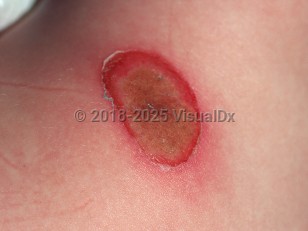Bullous impetigo
Alerts and Notices
Important News & Links
Synopsis

This summary discusses adult patients. Bullous impetigo in children is addressed separately.
Bullous impetigo is a superficial infection of skin typically caused by phage group II staphylococci and, less often, by other staphylococci phages. Additionally, there have been a few reports of beta-hemolytic streptococci causing bullous impetigo. The presentation of bullae is due to exotoxin-mediated cleavages of desmoglein-1.
It is primarily seen in children and does not commonly occur in teenagers or young adults. It presents as a painful eruption with fragile bullae and honey-colored crusting. Constitutional symptoms such as fever are rare and mild, if they occur. Staphylococcus aureus can secondarily infect the lesions of varicella, causing a bullous presentation. Disseminated bullous impetigo has been reported in patients with atopic dermatitis.
Infection is spread by direct contact with colonized or infected individuals. S aureus often colonizes the nares, umbilicus, nails, and eyes; approximately 5% of S aureus strains have exfoliative toxins. Outbreaks tend to occur during the summer months and in humid climates.
Methicillin-resistant S aureus (MRSA) first emerged as an important nosocomial pathogen in the 1960s. In more recent years, outbreaks of community acquired (CA)-MRSA have been described increasingly among healthy individuals lacking the traditional risk factors for such infections (eg, intravenous drug use, incarceration, participation in contact sports). The majority of purulent skin and soft tissue infections presenting to emergency rooms across the United States are caused by CA-MRSA.
Immunocompromised Patient Considerations:
Pyodermas (cutaneous bacterial infections) including impetigo are quite common in HIV-infected individuals. Additionally, pyodermas are found in immunosuppressed transplant patients, especially in the first months following transplant.
Recurrent bouts of impetigo are more common in immunocompromised patients. This may be due to persistent nasal carriage of S aureus, which has been reported to be as high as 50% in individuals with HIV.
Bullous impetigo is a superficial infection of skin typically caused by phage group II staphylococci and, less often, by other staphylococci phages. Additionally, there have been a few reports of beta-hemolytic streptococci causing bullous impetigo. The presentation of bullae is due to exotoxin-mediated cleavages of desmoglein-1.
It is primarily seen in children and does not commonly occur in teenagers or young adults. It presents as a painful eruption with fragile bullae and honey-colored crusting. Constitutional symptoms such as fever are rare and mild, if they occur. Staphylococcus aureus can secondarily infect the lesions of varicella, causing a bullous presentation. Disseminated bullous impetigo has been reported in patients with atopic dermatitis.
Infection is spread by direct contact with colonized or infected individuals. S aureus often colonizes the nares, umbilicus, nails, and eyes; approximately 5% of S aureus strains have exfoliative toxins. Outbreaks tend to occur during the summer months and in humid climates.
Methicillin-resistant S aureus (MRSA) first emerged as an important nosocomial pathogen in the 1960s. In more recent years, outbreaks of community acquired (CA)-MRSA have been described increasingly among healthy individuals lacking the traditional risk factors for such infections (eg, intravenous drug use, incarceration, participation in contact sports). The majority of purulent skin and soft tissue infections presenting to emergency rooms across the United States are caused by CA-MRSA.
Immunocompromised Patient Considerations:
Pyodermas (cutaneous bacterial infections) including impetigo are quite common in HIV-infected individuals. Additionally, pyodermas are found in immunosuppressed transplant patients, especially in the first months following transplant.
Recurrent bouts of impetigo are more common in immunocompromised patients. This may be due to persistent nasal carriage of S aureus, which has been reported to be as high as 50% in individuals with HIV.
Codes
ICD10CM:
L01.03 – Bullous impetigo
SNOMEDCT:
399183005 – Impetigo bullosa
L01.03 – Bullous impetigo
SNOMEDCT:
399183005 – Impetigo bullosa
Look For
Subscription Required
Diagnostic Pearls
Subscription Required
Differential Diagnosis & Pitfalls

To perform a comparison, select diagnoses from the classic differential
Subscription Required
Best Tests
Subscription Required
Management Pearls
Subscription Required
Therapy
Subscription Required
References
Subscription Required
Last Reviewed:06/05/2022
Last Updated:07/06/2022
Last Updated:07/06/2022
 Patient Information for Bullous impetigo
Patient Information for Bullous impetigo
Premium Feature
VisualDx Patient Handouts
Available in the Elite package
- Improve treatment compliance
- Reduce after-hours questions
- Increase patient engagement and satisfaction
- Written in clear, easy-to-understand language. No confusing jargon.
- Available in English and Spanish
- Print out or email directly to your patient
Upgrade Today

Bullous impetigo

